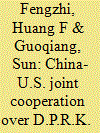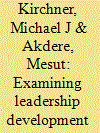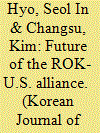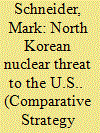| Srl | Item |
| 1 |
ID:
130609


|
|
|
|
|
| Publication |
2014.
|
| Summary/Abstract |
In February 12, 2013, North Korea announced it had successfully Conducted its third underground nuclear test. After such a dangerous move, the U.S. and South Korea tightened their bilateral security cooperation and beefed up defense measures. This caused tensions to escalate on the Korean Peninsula, and the situation appeared to spin out of control. The crisis pushed China and the U.S. together to work on this issue. This article will analyze those deep-seated factors affecting bilateral cooperation and make an initial exploration 'of its prospects while providing an overview of their joint actions to solve the North Korean nuclear issue.
|
|
|
|
|
|
|
|
|
|
|
|
|
|
|
|
| 2 |
ID:
134080


|
|
|
|
|
| Publication |
2014.
|
| Summary/Abstract |
The existing literature presents ample studies on leaders and leadership development in the United States Army. The contribution of many great military leaders of the U.S. are widely recognized both by the military community and the society at large. Reviewing the history of leadership development (LD) in the U.S. Army provides an opportunity to analyze American soldiers' development and transformation as strong leaders. Although U.S. Army training and its value systems, in many ways, have remained fundamentally the same with focus on hierarchy and structure, LD has been repeatedly refined, reframed, and redesigned based on the needs of the time and expectations of the leadership. This paper presents a review of the LD training in the U.S. Army to identify potential opportunities for the military of the Republic of Korea. It focuses on LD throughout critical periods in the history of the U.S. Army and illustrates how LD training has evolved historically. The paper also explores how Human Resource Development (HRD) as a discipline of study and its functions may be instrumental in LD by analyzing the U.S. Army's approach to LD, leadership training, organizational culture, and career development. Implications of LD for security and defense strategies are also discussed.
|
|
|
|
|
|
|
|
|
|
|
|
|
|
|
|
| 3 |
ID:
125260


|
|
|
|
|
| Publication |
2013.
|
| Summary/Abstract |
Over the past six decades, the alliance between the Republic of Korea and the United States has become one of the most successful military alliances in history. Numerous strategic changes are anticipated in Northeast Asia over the coming years, including the risk of a military attack by North Korea and a shift in the balance of power. Among multiple factors that contribute to the success of an alliance, one key factor is sharing a common vision of the future since sharing this is crucial to enhance the trust shared today and to reinforce the alliance's capability to respond effectively to any new challenges that may arise. This paper seeks to offer a vision for the ROK-U.S. alliance and make suggestions on how the alliance can develop and improve in the future by trying to forecast changes in the security circumstances surrounding the Korean Peninsula and Northeast Asia until around 2030. As a result, this paper finds the fact that maintaining the ROK-U.S. alliance is the optimal choice for both countries until 2030, despite the various strategic changes in Northeast Asia, including a possible national reunification of the Korean Peninsula and presents a long-term vision for the ROK-U.S. alliance based on this fact and some implementation strategies for this vision.
|
|
|
|
|
|
|
|
|
|
|
|
|
|
|
|
| 4 |
ID:
117831


|
|
|
| 5 |
ID:
132000


|
|
|
|
|
| Publication |
2014.
|
| Summary/Abstract |
A recent unclassified Defense Intelligence Agency (DIA) assessment stated: "DIA assesses with moderate confidence the North [Korea] currently has nuclear weapons capable of delivery by ballistic missiles." This conclusion is highly credible and not really new. North Korea was assessed to have nuclear weapons long before the actual (or at least detected) first test of these weapons in 2006. Building a nuclear weapon small enough to be carried by the relatively large payloads of North Korea's ballistic missiles is not a very difficult task today. In light of what is now known about the proliferation of a nuclear missile warhead from China to Pakistan and from Pakistan to North Korea, the North Korea defector reports about nuclear weapons development and the North Korean nuclear tests, the DIA conclusion may be an understatement. The North Korean nuclear stockpile may be significantly greater than what is usually assessed. This is of concern because the North Korean regime is the most brutal Stalinist dictatorship in the world. Moreover, while North Korea has long made occasional nuclear attack threats against the U.S. in the past, the scope, magnitude, and frequency of these threats vastly increased in 2013. Current U.S. policy, which downgrades the importance of nuclear deterrence and cuts missile defense, is not well suited to handle this threat.
|
|
|
|
|
|
|
|
|
|
|
|
|
|
|
|